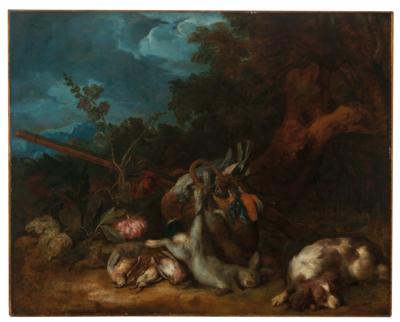Lodewijk de Deyster
(Bruges 1656–1711)
After the hunt, landscape with game and a sleeping dog,
indistinctly signed lower left: L. de Deyster f.,
oil on canvas, 118 x 148.5 cm, framed
Provenance:
Clare Jekyll, Dowager Lady Henley of Chardstock (1838–1922);
Private European collection
This exquisitely painted still life by the Fleming Lodewijk de Deyster is a unique work within the master’s oeuvre. Indeed, only one other hunting still life by his hand is listed in the database of the RKD, The Hague under no. 1113256. The refined treatment of the still life subject here is reminiscent of the works by de Deyter’s Dutch contemporary, Jan Weenix (1641/49–1719). Like Weenix, de Deyster’s considerable talent lies in his ability to depict texture, notably the furs and feathers of the various animals. In the late-seventeenth and early-eighteenth centuries, hunting was exclusively the privilege of the nobility and it was illegal for the increasingly wealthy mercantile class to participate in the sport. Accordingly, paintings such as this were highly popular among the aristocratic class, lending them a mark of social prestige.
De Deyster was primarily known as a history painter, draftsman, engraver and musical instrument maker. Active in Bruges, he made a formative trip to Italy, returning home in 1688 and bringing with him a flamboyant, Roman Baroque style. De Deyster was also a harpsichord, violin and organ builder. In 1707, he was commissioned to complete the Jacob van Eynde organ in St. Anne’s Church in Bruges, as well as the organs for the church of the Holy Cross and for the Bogarden Chapel. According to contemporary reports, his passion for making musical instruments instead of painting reduced him to poverty.
Expert: Dr. Alexander Strasoldo
 Dr. Alexander Strasoldo
Dr. Alexander Strasoldo
+43 1 515 60 403
oldmasters@dorotheum.com
25.10.2023 - 18:00
- Odhadní cena:
-
EUR 20.000,- do EUR 30.000,-
Sledovat položku Sledování ukončit
Lodewijk de Deyster
(Bruges 1656–1711)
After the hunt, landscape with game and a sleeping dog,
indistinctly signed lower left: L. de Deyster f.,
oil on canvas, 118 x 148.5 cm, framed
Provenance:
Clare Jekyll, Dowager Lady Henley of Chardstock (1838–1922);
Private European collection
This exquisitely painted still life by the Fleming Lodewijk de Deyster is a unique work within the master’s oeuvre. Indeed, only one other hunting still life by his hand is listed in the database of the RKD, The Hague under no. 1113256. The refined treatment of the still life subject here is reminiscent of the works by de Deyter’s Dutch contemporary, Jan Weenix (1641/49–1719). Like Weenix, de Deyster’s considerable talent lies in his ability to depict texture, notably the furs and feathers of the various animals. In the late-seventeenth and early-eighteenth centuries, hunting was exclusively the privilege of the nobility and it was illegal for the increasingly wealthy mercantile class to participate in the sport. Accordingly, paintings such as this were highly popular among the aristocratic class, lending them a mark of social prestige.
De Deyster was primarily known as a history painter, draftsman, engraver and musical instrument maker. Active in Bruges, he made a formative trip to Italy, returning home in 1688 and bringing with him a flamboyant, Roman Baroque style. De Deyster was also a harpsichord, violin and organ builder. In 1707, he was commissioned to complete the Jacob van Eynde organ in St. Anne’s Church in Bruges, as well as the organs for the church of the Holy Cross and for the Bogarden Chapel. According to contemporary reports, his passion for making musical instruments instead of painting reduced him to poverty.
Expert: Dr. Alexander Strasoldo
 Dr. Alexander Strasoldo
Dr. Alexander Strasoldo
+43 1 515 60 403
oldmasters@dorotheum.com
|
Horká linka kupujících
Po-Pá: 10.00 - 17.00
old.masters@dorotheum.at +43 1 515 60 403 |
| Aukce: | Obrazy starých mistrů |
| Typ aukce: | Sálová aukce s Live bidding |
| Datum: | 25.10.2023 - 18:00 |
| Místo konání aukce: | Wien | Palais Dorotheum |
| Prohlídka: | 14.10. - 25.10.2023 |
Všechny objekty umělce

